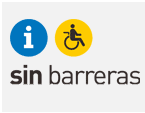Disability Assistance at Alicante Airport
Alicante Airport is fully wheelchair accessible. For passengers with disabilities, there is an assistance service called “Sin Barreras”.
➪Who is eligible
➪How to get assistance
➪Meeting points at ALC
➪What type of asssitance is provided
➪Hidden disabilities
➪Information on flying with reduced mobility
About “Sin Barreras”
“Sin Barreras” is Spanish and means barrier-free. The service is free of charge and is intended to help passengers with disabilities to cope with the long distances at the airport and to find their way around the terminal building.
Who Can Get Assistance
Passengers who are experiencing a permanent or temporary limitation in mobility, or other disability that would make it difficult to navigate the airport and board the plane unaided. If you are unsure whether you will need assistance, do consider the fact that you will have to walk a fair distance through the airport’s long corridors. Therefore, if you have walking difficulties, you may find it easier to use an airport transporter or wheelchair which can be arranged by your airline in advance.
Requesting Disability Assistance
If you need disability assistance, it is important that you inform your airline as soon as possible – ideally at the time of booking – and a minumium of 48 hours before your scheduled flight. Additionally, you can contact Alicante Airport under the following link:

These days, the majority of people book their flights online. At the end of you online booking process and and before you finalise your booking, you will find a section or button called something along the lines of “passenger assistance/special needs/ access requirements”. Clicking on this will open the section where by you can give details of the assistance needed. This is usually done by ticking boxes describing the help that is required.
It is essential to give clear information of all your needs to ensure that things run smoothly during your journey. Your airline will send the details of your required disability assistance to the airport. The airport assistance staff will be prepared to meet you and take you to the aircraft, providing equipment where necessary.
What does “PRM” stand for?
In aviation jargon, passengers with disabilites are often referred to as PRM. This abbreviation stands for passenger with reduced mobility, although it also includes disabled passengers whose mobility is not affected. It comes from a globally recognised code system that gives airport staff and flight attendants more information about the assistance required by each passenger. A list of the different PRM codes can be found at the bottom of this page.
Disability Assistance Meeting Points at Alicante Airport

At Alicante airport there are a number of different meeting points where you can be picked up by the Sin Barreras team. These are easy to recognise due to the “Sin Barreras” signage. Each meeting point is equipped with an intercom system that you can use to contact the team. However, please remember that you must book the service at least 48 hours in advance. The different meeting points are well distributed around the airport.
| OUTSIDE THE AIRPORT TERMINAL |
| Car park -North Lobby -South Lobby |
| Level 0 -Arrivals, outside terminal building |
| Level 2 -Bus stop outside the airport terminal -Departures, outside the airport terminal |
| INSIDE THE AIRPORT TERMINAL |
| Level 0 -PRM information office, baggage reclaim |
| Level 2 -Billing office PRM -Information office PRM shipments -Security checkpoint (public area) |
Assistance provided by the airport’s reduced mobility team:
Depending on your individual needs, the following services can be provided:
- Meet and accompany the passenger to and from the meeting point
- Help with hand luggage
- Take you a to the check-in desk and assisting
- Accompany you through the security check-point and customs
- Assist with boarding and disembarking
Hidden Disabilities
Provisions are in place at Alicante Airport for people with hidden disabilities. These can include a range of conditions like ASD, anxiety disorders, learning disabilities and many more.
Invisible disabilities badge
Passengers with this type of disability may be physically fit to navigate the airport without the need for the Sin Barreras service. However, they might find the busy environment difficult to cope with and need a bit of extra time and an understanding attitude from airport staff when proceeding through the airport.
For this purpose, the airport operator has devised an “invisible disabilities badge“, with an icon as shown below. Passengers with a hidden disability or their travel companions can apply for this prior to their planned journey. The badge lets the airport staff know that the passenger may need some additional support or time, without the need for further explanations.
The badge can be requested via the AENA website. You can access the page by clicking on the badge icon below. The badge is single-use: it is only valid on the date of your flight and at the specific airport, you are flying to or from.

Please also remember that the badge does not entitle you to use the Sin Barreras service. If this service is needed, it has to be requested separately (please see above).
Sensory room
A sensory room is available for passengers with sensory processing disorders. This is equipped with a variety of sensory stimuli, such as lights, sounds, and tactile objects, to provide a relaxing, calm and safe space, away from the hectic airport environment. The room is located close to the boarding area. Please speak to the Sin Barreras Team at Alicante Airport to gain access.
Most Accessible Airport in Europe
Alicante Airport has received the 2023 Airports Council International Award for being the most accessible airport in Europe. In addition, the airport was honoured for exemplary accessibility initiatives by the Committee of Entities representing people with disabilities of the Valencian Community (CERMI CV).
This is due to its implementation of innovative tools and services for travellers with disabilities. These include direct communication channels for assistance with the airport (in addition to the communication with the airlines), designated charging points for power chairs, user-friendly mobile apps to aid visually impaired passengers in navigating the airport, and dedicated PRM (Persons with Reduced Mobility) lanes for security and passport controls.
Flying with Reduced Mobility
Getting on the Aeroplane
If your plane is not connected by an airbridge and you are unable to climb the stairs to the aircraft, you will be able to use the mobile lift for passengers with reduced mobility.
Airplane seating
The airline will in most cases select an appropriate seat without charge, depending on your required assistance. The selected seats will be chosen near the toilets and next to any passengers travelling with you. The seat selected will have armrests that lift out of the way to aid easy access.
Airplane toilets
Unfortunately, aeroplane toilets are often a challenge and even unusable for some passengers with a disability.
If you are able to use the onboard toilets, then the cabin crew can offer some help to push the onboard wheelchair. However, cabin crew are not permitted to assist with the use of the toilet or to help lift passengers.
The on-board toilet compartment is very small and the on-board wheelchair can only be taken up to the toilet door as it won’t fit inside. All onboard toilets are fitted with rails and grab handles. The doors open outwards which helps the transition from wheelchair to grab handle inside the toilet compartment.
If you require physical assistance with toileting, you may need to consider a travel companion (please see below). Alternatively, there are a range of continence solutions. You would need to discuss this ahead of time with your local health practitioner.
Travelling Companions
The Sin Barreras team will take you all the way onto the aircraft and can assist you with the transfer into your seat before they leave you in the hands of the cabin crew. Contrary to the Sin Barreras staff, members of the cabin crew on the aircraft are not permitted to provide you with physical assistance of any kind. Therefore, if you are travelling alone, you must be able to perform the following activities independently on the aircraft:
- Fasten and unfasten your seat belt
- Put on the oxygen mask
- Get the lifejacket out from under the seat and put it on.
- Exit the aircraft, possibly via emergency exits.
- Understand and follow safety instructions
If you require assistance in any of the above situations, you must travel with a companion. This person must be physically able to help you with the activities you cannot do alone. Depending on the airline, this person must be at least 16 or 18 years old. Find out when you make your booking.
Wheelchair Users
Transporting your wheelchair
The airlines are required to transport your mobility equipment free of charge. For this to happen, you must inform the airline when you book, especially if you have a scooter or powered wheelchair with batteries.
Due to safety regulations, passengers are not allowed to take certain types of mobility equipment on board, Instead, this will be stored with luggage in the hold. Batteries also are required to be stored in the hold for security.
A manual folding wheelchair may be stored in the passenger cabin, depending on space. If you need to use a wheelchair on board, this has to be requested when booking.
Moving around the airport and boarding the aircraft
Depending on the situation, you may be able to stay in your own chair up until entry into the aircraft. However, if your wheelchair or scooter needs to be placed into the aircraft hold, you may need to swap it at the check-in desk for a wheelchair provided by the airport support staff.
The wheelchair swapping point can vary depending on the boarding method and facilities available for the particular gate at Alicante Airport. When it’s time to board the plane, you will need to transfer into an onboard chair or boarding chair. This is narrower than your own chair to ensure that it fits through the small airplane aisles.
Special Service Request (SSR) Codes
These codes are used internationally by airports and airlines and can be helpful in informing the airport of what kind and what level of assistance is needed.
| PRM | Passenger with reduced mobility |
| WCHC | Passengers are not self-sufficient and are entirely immobile They require help to their seats and complete personal assistance When the flight time is longer than three hours they need a travel companion They need help in the terminal between arrival and departure points |
| WCHS | Passengers who are self-sufficient once on the aeroplane They need help from the terminal to the aircraft and boarding They need help in the terminal between arrival and departure points |
| WCHR | Passengers who can boardwalk up steps and move freely by themselves on the aeroplane They need help getting from the terminal to the aeroplane They need help in the terminal between arrival and departure points |
| BLND | Visual disabilities |
| DEAF | Deaf passengers |
| DEAF/BLIND | Blind and deaf person who can only move about with the aid of an accompanying person |
| DPNA | Passengers with an intellectual or developmental disability |
| WCMP | Manual wheelchair transported by passenger |
| WCBD | Dry Cell Battery Wheelchair transported by passenger which may need (dis)assembly |
| WCBW | Wet Cell Battery wheelchair transported by passenger which may need (dis) assembly |
Further Information
See also our page:
Other Resources
The Queen Elizabeth Foundation in partnership with the UK Civil Aviation Authority has produced a video guide about air travel in a wheelchair, which covers everything, from the preparation and planning needed before the flight, procedures at the airport, boarding the aircraft, what to consider during the flight and disembarking.
